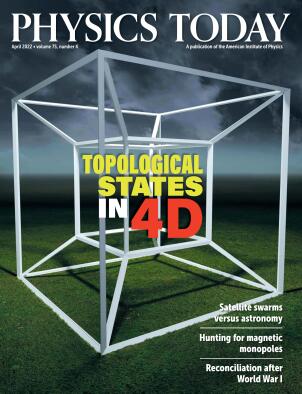Hendrik Lorentz, Robert Millikan, and interwar reconciliation
DOI: 10.1063/PT.3.4980
A photograph hangs in the stairwell of the east wing of Caltech’s Norman Bridge Laboratory of Physics. Dating from 1922, it depicts 25 professors and students posing in their Sunday best with a dog lying at their feet (see figure
Figure 1.

Caltech faculty, students, and staff pictured with Hendrik Lorentz during his 1922 visit. Behind the dog sit Lorentz (with the white beard) and Robert Millikan, to the left of him. A copy of this photo hangs in Caltech’s Norman Bridge Laboratory of Physics. (Courtesy of the Caltech Archives.)
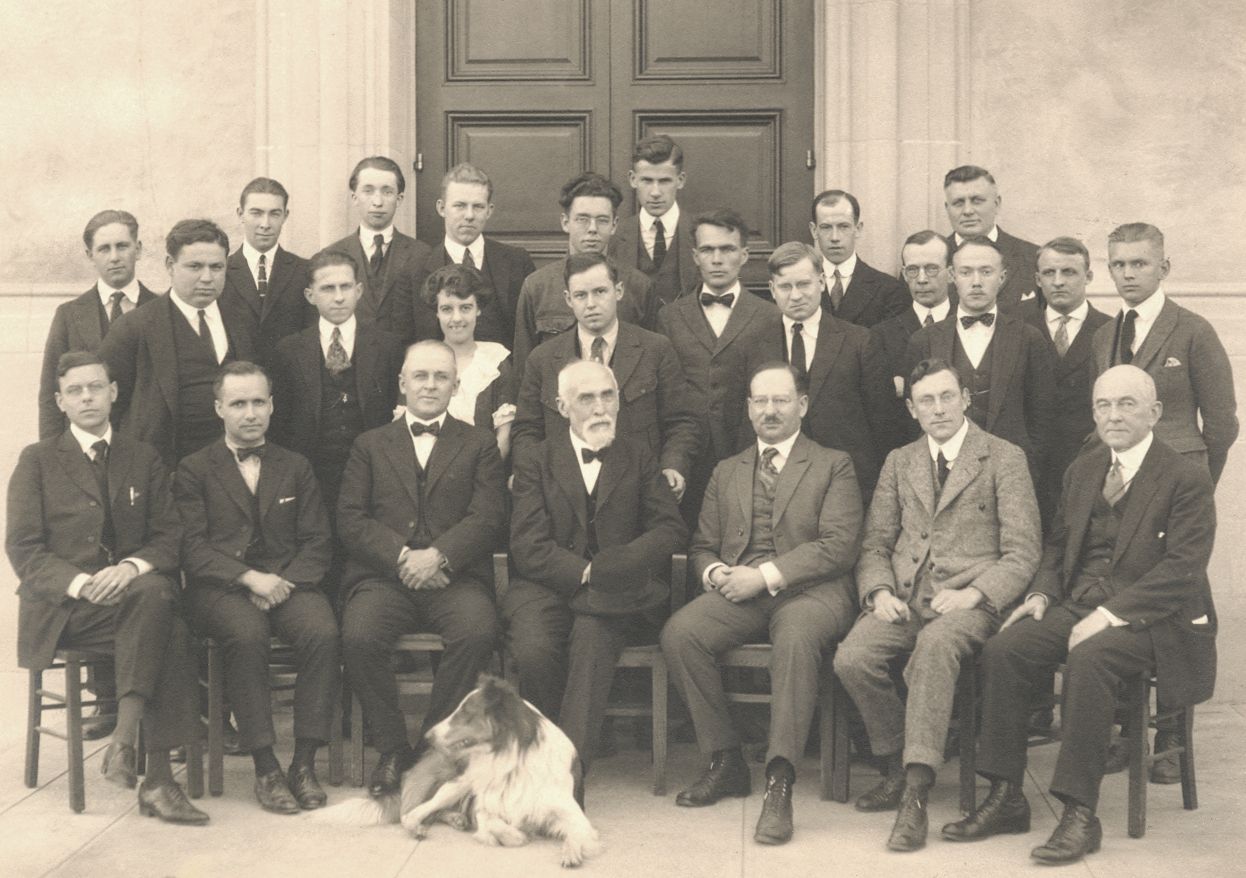
Millikan and Lorentz are celebrated for their tremendous contributions to early-20th-century physics. But they also made their mark in the realm of international science policy. Based on the archives of Millikan and Lorentz in Pasadena, California, and Haarlem, the Netherlands, respectively, this article reconstructs a little-known aspect of that work: their joint effort to restore scientific cooperation between countries that had fought hard to destroy each other during World War I.
Four long years of bloody warfare had engendered tremendous hatred between scientists who cooperated amicably before the war but then ended up on opposite sides of the trenches. In their capacity as members of the League of Nations’ International Committee on Intellectual Co-operation—the precursor of today’s UNESCO—Lorentz and Millikan tried to make peace between the two sides.
Lorentz and Millikan
Born in 1853, Lorentz (see box
Figure 2.

A group portrait from the Third Solvay Conference on Physics, held 1–6 April 1921. In the front row sit Hendrik Lorentz (fourth from right) and Robert Millikan (second from right). Between the two is Ernest Rutherford; Marie Curie sits to the right of Millikan. Apart from Albert Einstein, who was a dual German–Swiss citizen, German physicists were not invited to attend the conference because of lingering wartime resentment. (Photograph by Benjamin Couprie; courtesy of the International Solvay Institutes, Brussels.)
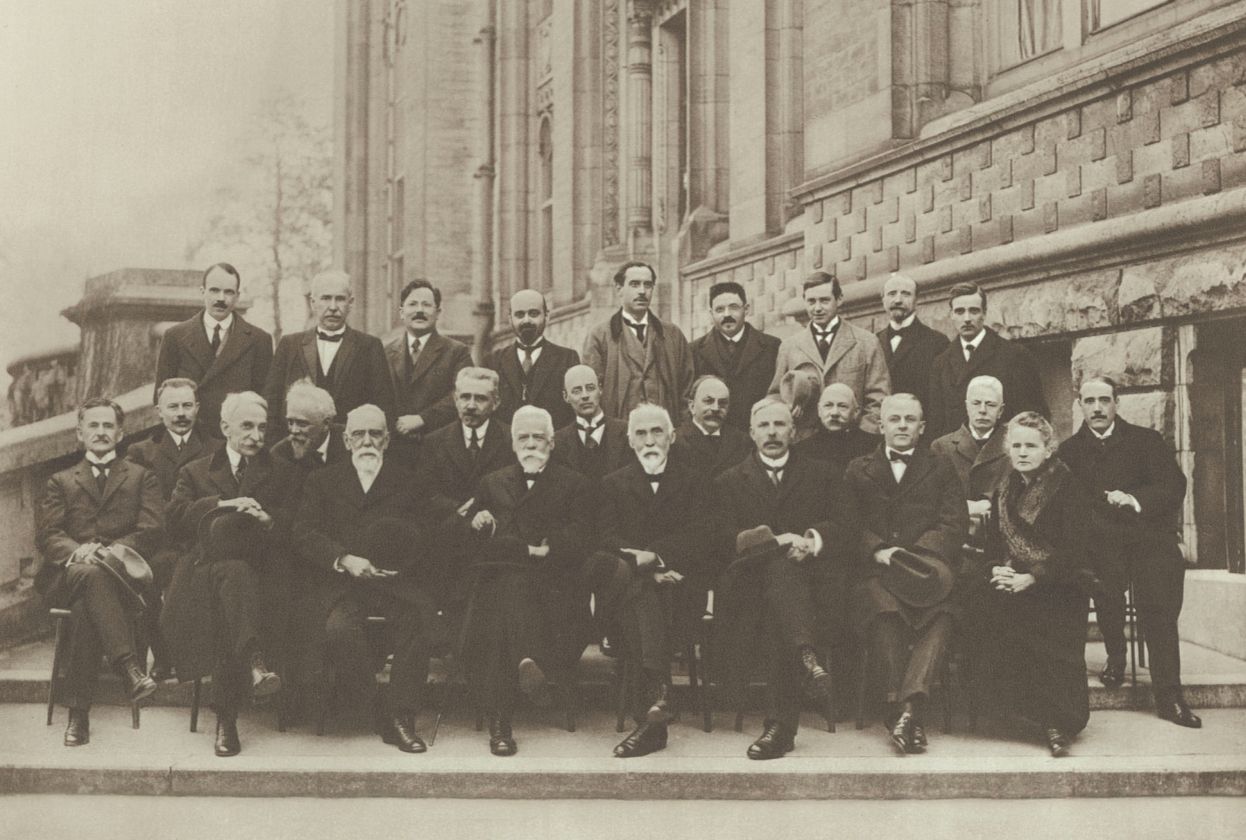
Hendrik Lorentz (1853–1928)
The son of a vegetable farmer, Hendrik Lorentz grew up in the provincial town of Arnhem in the eastern Netherlands. 15 He went to Leiden University in 1870 to study mathematics and physics. His doctoral work culminated in an 1875 PhD thesis on the reflection and refraction of light that extended Maxwell’s theory of electromagnetism.
In 1877 Lorentz proposed the existence of minute, charged particles that were part of atoms and would later be called electrons. He formalized his electron theory in 1892. Published in its definitive form in 1904, the theory introduced the concepts now known as the Lorentz force, the Lorentz contraction, and the Lorentz transformation. Two years later Lorentz gave a series of lectures on that theory at Columbia University. They were published in 1909 as The Theory of Electrons and Its Applications to the Phenomena of Light and Radiant Heat.
In 1896 Lorentz used his electron theory to explain how spectral lines split under the influence of a magnetic field, which is commonly known as the Zeeman effect. Together with Pieter Zeeman, who experimentally discovered that behavior, Lorentz was awarded the 1902 Nobel Prize in Physics for that work. But he was unable to explain the anomalous Zeeman effect that Millikan and others soon discovered.
In 1912 Lorentz moved to Haarlem, where he led the Teylers Museum’s research laboratory. That new position brought him relief from the heavy lecturing duties he had while he was teaching theoretical physics at Leiden University, although he continued to give lectures as a professor by special appointment. He primarily used his newly found spare time to further international scientific cooperation through work with the International Research Council, the International Committee on Intellectual Co-operation, and the International Solvay Institutes. Thanks to his tact, his command of languages, and the esteem with which he was held in the international physics community, Lorentz chaired the first five Solvay Conferences.
Lorentz left the lab in 1923 but continued to lecture at Leiden. He kept abreast of the new developments in relativity and quantum theory in the 1920s and even lectured on the latter topic at Cornell University during a 1926–27 US trip (see figure
As figure
Robert Millikan (1868–1953)
The son of a minister, Robert Millikan spent his childhood in Morrison, Illinois. 16 In 1886 he began studying at Oberlin College in Ohio, where he obtained a BA in 1891 and an MA in 1893. He then went to Columbia University, where he became the institution’s first PhD recipient in physics. After obtaining his doctorate in 1895, Millikan toured Europe for a year. Upon his return, Albert Michelson secured him an assistant professorship at the University of Chicago.
After 10 years at Chicago, Millikan decided to “get busy on some more serious research.” That resulted in two brilliant proofs of his experimental talents. In 1910 he used falling oil droplets to prove the existence of an elementary charge, which he determined to be 1.6 × 10−19 coulombs. He then embarked on a series of ingenious investigations in which he experimentally confirmed Einstein’s 1905 equation for the photoelectric effect and calculated the value of Planck’s constant h with unparalleled accuracy. That work earned him the 1923 Nobel Prize in Physics.
The promise of a better salary and a new laboratory persuaded Millikan to move to Caltech in 1921. Under his leadership, the Norman Bridge Laboratory of Physics quickly developed into one of the world’s most prestigious physics centers. After his retirement in 1945, he remained involved in experiments on cosmic radiation. Notably, Millikan maintained a lifelong aversion to government interference in science; rather, he argued that wealthy philanthropists, businessmen, and the public should support centers of scientific research, such as Caltech and other universities. 17
Active in the public sphere, Millikan was often featured in the media and took part in local social and literary clubs. His public-facing activities extended to an ignominious aspect of his legacy—namely, his firm belief in eugenics. Many scientists of Millikan’s era espoused such beliefs privately, but Millikan went much further: In 1937 he joined the board of trustees of the Human Betterment Foundation, a California-based organization that advocated eugenic sterilization of “mentally deficient” individuals.
Although Millikan did not have much influence on the organization’s policies or strategy, a 2020 Caltech report concluded that his fame likely gave it “renewed legitimacy” in an era when Nazi sterilization policies were beginning to discredit eugenics. 18 As a result, Caltech decided in 2021 to remove his name from the university library, a professorship, and a fellowship fund. Other organizations with awards or buildings named after Millikan have followed suit.
The second step in Hale’s plan was to invite famous foreign physicists to come to Pasadena as visiting professors. Lorentz was the first of Hale’s invitees, which was no coincidence: He was the most highly respected theoretical physicist of the day. Other star scientists from Europe, including Albert Einstein, Paul Ehrenfest, Werner Heisenberg, Erwin Schrödinger, and Arnold Sommerfeld, would follow in his footsteps.
The newly finished Norman Bridge Laboratory was inaugurated during Lorentz’s stay in Pasadena, and he was invited to speak at the opening ceremony on 28 January 1922. Tellingly, Lorentz’s speech sang the praises of “physicists [who] form a kind of fraternity spread all over the world.” Even though the world had recently emerged from a disastrous war, Lorentz said, “I am deeply convinced of this unity of science.” 3
International Research Council
Both Hale and Millikan were heavily involved in reorganizing international science after the Great War. Prior to the conflict, Hale had served as the foreign secretary of the US National Academy of Sciences. In that position, he became acquainted with the International Association of Academies, an umbrella organization that was intended to link scientific institutions across the globe. But that organization had achieved little since its founding in 1899. Hale believed that Allied countries should start something new.
To that end, he convened a meeting of scientists from Allied countries in London on 9 October 1918. Although it was preliminary in nature, the meeting foreshadowed what was to come: The US and UK delegates argued that Germany and the other Central powers should eventually be allowed to join the new international organization if they openly rejected the political actions that had led to the war. But that view touched a raw nerve with the Belgian and French delegates, who believed that the Central powers should be excluded.

Hendrik Lorentz in his study in Haarlem, the Netherlands, during the 1920s. A portrait of Albert Einstein is visible on the wall at right. (Courtesy of Rijksmuseum Boerhaave, Leiden, the Netherlands.)
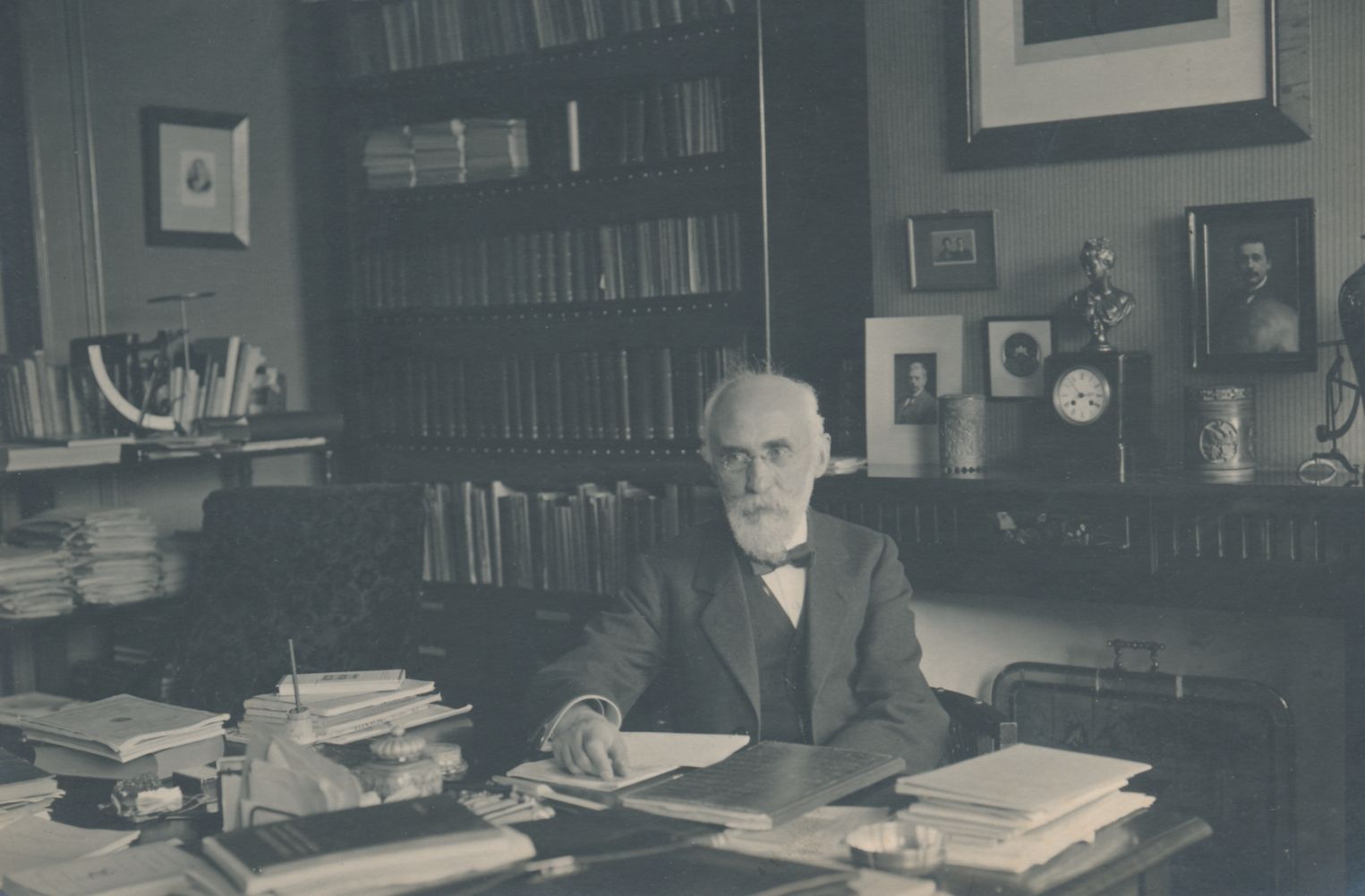
After another preparatory meeting in Paris, the new organization Hale envisioned—named the International Research Council (IRC)—was established on 28 July 1919, shortly after the signing of the Treaty of Versailles. Based in Brussels, the IRC served as an umbrella organization. International unions for specific disciplines, such as astronomy, chemistry, and geophysics, became its subsidiaries. The International Union of Pure and Applied Physics 4 joined the IRC in 1922.
In a concession to the French and Belgian delegates, the IRC bylaws explicitly excluded the former Central powers from membership. Yet in the early 1920s, many scientists from both formerly neutral and Allied nations began to campaign for admitting the defeated nations into the IRC. At the second IRC assembly in July 1922, the Swedish delegates proposed taking a more lenient attitude toward the Germans. The Belgian and French delegates refused to give way, which led to fierce clashes. Even a watered-down version of the Swedish proposal drove the French and Belgians into a frenzy. “Never!” they shouted.
Similar sentiments were in evidence at the 1924 meeting of the International Mathematical Union in Toronto. A huge commotion broke out when it became clear that delegates from Germany, the country of such mathematical giants as David Hilbert and Felix Klein, had not been invited because of the IRC bylaws. The US delegates proposed a motion to lift the ban. Although it was supported by the delegates from Denmark, the UK, Italy, the Netherlands, Norway, Sweden, and Switzerland, IRC regulations precluded such a move.
Hale, a member of the IRC’s executive committee, was increasingly embarrassed by the continued ban on German participation. He feared that the organization was doomed if the ban was not scrapped at the next IRC assembly in 1925. As he wrote to the executive committee’s British representative, the physicist Arthur Schuster, the IRC could not “afford” to let the “iron hand” of the French “wreck the whole organization.” Germany needed to be admitted as soon as possible. Hale was not alone in that belief: He wrote to Schuster that Millikan felt similarly and “much more strongly than I do.” 5
Millikan and the IRC
After receiving the Nobel Prize in Physics in December 1923—for which he had received warm congratulations from Lorentz—Millikan spent a few months in Europe. In May 1924 he gave his Nobel lecture in Stockholm, and in early June he and his wife visited Lorentz in Haarlem. Another item on Millikan’s European itinerary was attending a meeting of the IRC executive committee, where he stood in for Hale, who was having health problems.
Believing that “all members” of the executive committee were ready to “move in broadening and bettering the conditions of international contact among scientific men,” Millikan struck a positive note after the meeting. As he wrote to a colleague, “I have not the slightest doubt myself that Germany will be invited to full participation next July.” Millikan believed that the IRC had proved its usefulness. It would only improve, he wrote in a biting aside referring to the US refusal to join the League of Nations, if “it is found possible to keep out of it the sort of spirit and attitude which has made the United States non cooperative since the war.” 6
At the third IRC assembly, held in Brussels in July 1925, the Dutch and Danish delegates made a joint proposal to lift the ban on German membership. It was defended with great verve by Lorentz, who pleaded with Millikan beforehand to adopt “an attitude of benevolent neutrality.” 7 Millikan, who was again standing in for Hale, told Lorentz that the pressure to admit Germany was “so strong” in the US that he was “very sure that the International Research Council itself will go to pieces unless some constructive action is taken in Brussels next summer.” 8
Although a majority of representatives at the meeting voted to lift the ban, the motion nevertheless failed because amendments to the IRC bylaws required the support of two-thirds of the total number of IRC member countries to pass. Because many IRC members did not attend the meeting, German admission would have been rejected even if all the countries present in Brussels had voted in favor. Fury reigned.
At an extraordinary meeting of the IRC in June 1926, the ban was finally lifted. Germany and its former allies Austria, Hungary, and Bulgaria were immediately invited to join the organization. But the Germans refused to eat humble pie. Against the express wishes of their own government, the German academies declined to join the IRC. It was not until 1952 that the West German academies would join the IRC’s successor, the International Council of Scientific Unions, and 1961 when the East German academies entered.
International Committee on Intellectual Co-operation
In the meantime, Lorentz and Millikan had both joined the International Committee on Intellectual Co-operation (ICIC), an advisory committee to the League of Nations. The ICIC was a child of the league’s idealism: It was based on the idea that cultural cooperation between intellectuals from formerly warring countries would build mutual trust between nations and therefore promote world peace.
Chaired by the famed French philosopher Henri Bergson, the ICIC consisted of 12 members drawn from the intellectual elite, including Marie Curie, Einstein, and Hale (see figure
Figure 3.

Robert Millikan (center) in conversation with Albert Einstein (left) and Marie Curie (right) at a meeting of the International Committee on Intellectual Co-operation in Geneva in 1924. (Courtesy of the Caltech Archives.)

Ever the idealist, Bergson grandiloquently complimented the League of Nations on behalf of all intellectuals in the world for conceiving the “fine and noble idea” to found the ICIC. 10 Millikan, in contrast, offered sober realism: “The influence of the Committee on Intellectual Cooperation,” he wrote in a letter to Bergson, “will be measured by the practicability and the success of the plans which it initiates.” In comparison to the IRC and its unions, he argued that the ICIC would have to utilize existing initiatives developed by universities and libraries to promote the exchange of teachers, students, and scientific publications. As he concluded, “Money for scientific research is collected a hundred times more easily through the aid of a local appeal and a local interest than through the aid of any general appeal.” 11
Lorentz joined the ICIC in April 1923. Although he was motivated by a sense of humanitarian duty, he was clear-eyed about the ICIC’s limitations. He quickly made a positive impression on those involved with the committee. As the League of Nations’ Japanese undersecretary Inazō Nitobe informed Millikan, who was absent at the first ICIC meeting Lorentz attended in August 1923, “Your old friend, Dr. Lorentz, was a great acquisition. His wisdom and geniality were indispensable.” 12 When Bergson was forced to step down from the chairmanship in January 1926 because of health problems, Lorentz was chosen as his successor.
The July 1924 ICIC meeting in Geneva brought a major surprise: The French government generously offered to fund an executive institute for the ICIC that would be housed in a Parisian palace. Although the offer was tempting, several committee members had reservations about aligning the ICIC with France. Millikan was worried about moving league matters to Paris. Einstein agreed and argued that having the headquarters in Geneva ensured neutrality. Millikan and Lorentz proposed integrating the tasks of the new institute with the activities of existing ICIC subcommittees. But certain matters could not be tampered with: As an advisory committee of the League of Nations, the ICIC needed to remain headquartered in Geneva.
A final attempt
Lorentz worked toward scientific reconciliation up to the last stroke of his pen. The very last letter he wrote, which he began drafting on 20 January 1928, was to Millikan. In that letter, which remained unfinished after Lorentz came down with a high fever, he brought Millikan up to speed on several ICIC initiatives.
Figure 4.

Hendrik Lorentz lecturing at Cornell University in 1926 during one of his US tours. (Courtesy of the Division of Rare and Manuscript Collections, Cornell University Library.)
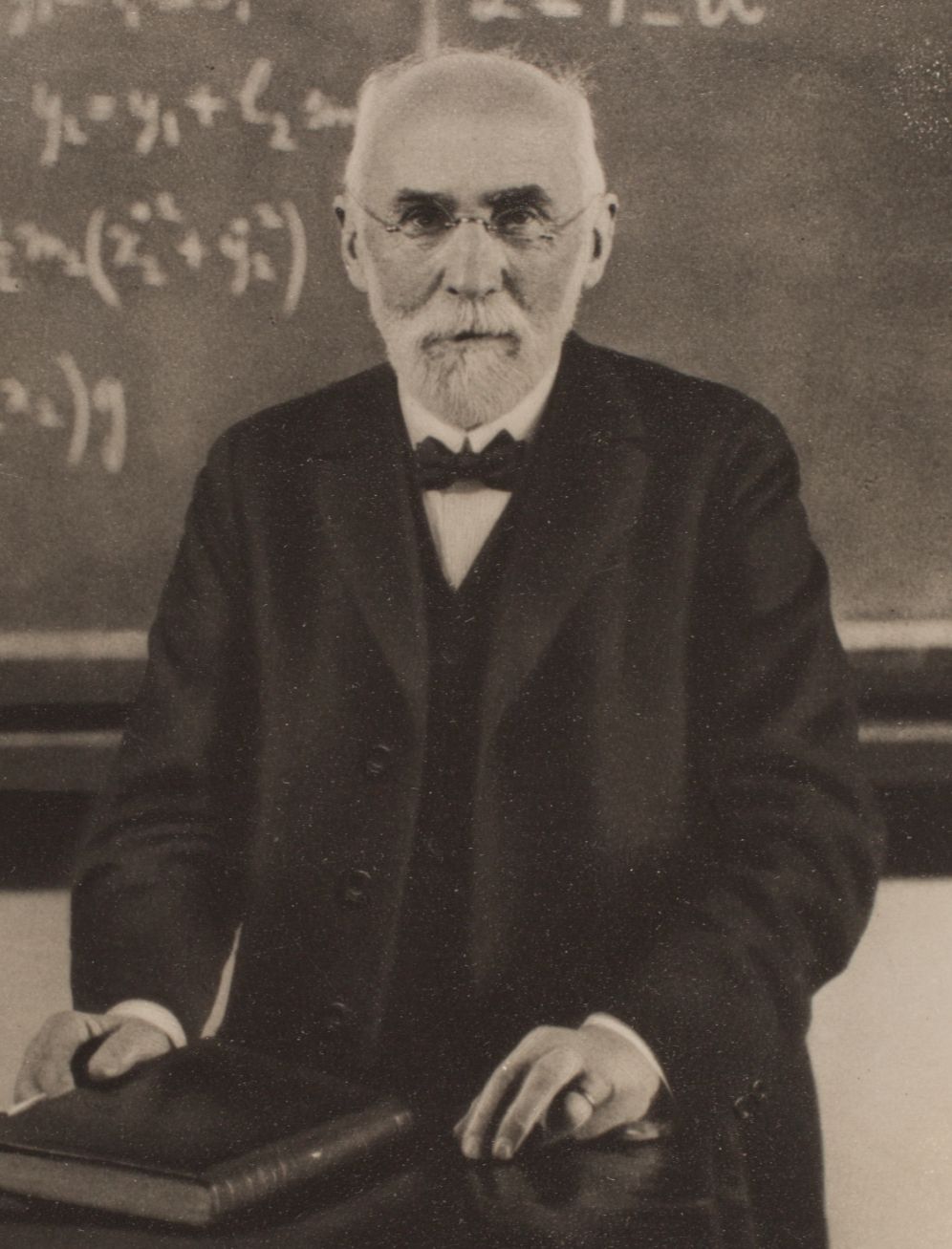
One of those plans lay close to Lorentz’s heart: convening a small-scale international meeting to persuade the reluctant Germans to join the IRC. A previous attempt to achieve that in summer 1926 had failed because the Germans had not yet joined the League of Nations. But Germany was finally admitted to the league later that fall. Millikan saw that as an auspicious sign and suggested to Lorentz in September 1927 that they try again.
Lorentz agreed and began planning the meeting. He envisioned that the attendees would be himself and Einstein on behalf of the ICIC, several presidents of German academies, several members of the IRC’s executive committee, a representative of the Royal Society of London, and a League of Nations staff member.
Lorentz explained the initiative to Millikan as follows: “The task of the committee would be to consider in a friendly spirit the way in which we may best reach the really universal collaboration which we all desire. If for this purpose it should be felt desirable that the organization which exists now be more or less modified, we should have to examine the nature and the possibility of these modifications.” 13
Sadly, it again proved difficult to organize a reconciliatory meeting. The Germans refused to go to Geneva, so Haarlem—where Lorentz lived—was proposed as an alternative. Plans began to collapse after the German undersecretary to the League of Nations, Albert Dufour-Féronce, who had been involved with the planning process, announced that he would not attend the meeting. The League of Nations then asked Lorentz to serve as chairman, but he feared that little would result from a meeting that had lost its official character.
Figure 5.

The Lorentz Medal is awarded by the Royal Netherlands Academy of Arts and Sciences every four years to an outstanding theoretical physicist. First awarded to Max Planck in 1927, the medal was endowed in 1925 in honor of the 50th anniversary of Hendrik Lorentz receiving his doctorate.

None of that mattered in the end, however, as Lorentz passed away “calmly and peacefully” on 4 February 1928. His student and successor, Adriaan Fokker, sent a copy of the unfinished letter to Millikan with an accompanying note stating that it was “a great pity Professor Lorentz has not lived to see the general reconcilement for which he so strongly longed.” 14
Tragically, Lorentz’s dream of international scientific reconciliation would not be realized for many years. Even the small victories he and Millikan achieved were undone in the 1930s and 1940s when international relations were soured by the rise of nationalism, fascism, and Nazism. Only after World War II, in 1954, would the German Physical Society join the International Union of Pure and Applied Physics.
The author would like to thank the reviewers for their comments and Frits Berends for valuable discussions.
References
1. Special issue, “The Early Solvay Councils and the Advent of the Quantum Era,” Eur. Phys. J. Spec. Top. 224 (2015).
2. R. Millikan to H. Lorentz (15 April 1921), file 54, Hendrik Lorentz Papers, North Holland Archives, Haarlem, the Netherlands.
3. H. Lorentz, Bull. Calif. Inst. Technol. 31(94), 33 (1922), p. 34.
4. F. Greenaway, Science International: A History of the International Council of Scientific Unions, Cambridge U. Press (1996).
5. G. E. Hale to A. Schuster (2 May 1924), box 47, folder 1, George Ellery Hale Papers, Caltech Archives.
6. R. Millikan to W. Willcox (17 October 1924; carbon copy), box 13, folder 19, Robert Andrews Millikan Papers, Caltech Archives.
7. H. Lorentz to R. Millikan (28 February 1925), box 41, folder 10, in ref. 6.
8. R. Millikan to H. Lorentz (4 February 1925), file 54, Lorentz papers, in ref. 2.
9. League of Nations Committee on Intellectual Co-operation, Minutes of the First Session: Geneva, August 1st–5th, 1922 (11 October 1922), p. 21.
10. Ref. 9, p. 39.
11. R. Millikan to H. Bergson (2 November 1922; carbon copy), box 13, folder 17, Millikan papers, in ref. 6.
12. I. Nitobe to R. Millikan (10 August 1923), box 13, folder 17, Millikan papers, in ref. 6.
13. H. Lorentz to R. Millikan (20 January 1928; copy of unfinished letter made by A. Fokker), box 41, folder 10, Millikan papers, in ref. 6.
14. A. Fokker to R. Millikan (20 February 1928), box 41, folder 10, Millikan papers, in ref. 6.
15. F. Berends, D. van Delft, Lorentz: gevierd fysicus, geboren verzoener (Lorentz: Celebrated Physicist, Born Mediator), Prometheus (2019).
16. R. H. Kargon, The Rise of Robert Millikan: Portrait of a Life in American Science, Cornell U. Press (1982);
L. A. du Bridge, P. S. Epstein, in Biographical Memoirs, vol. 33, National Academy of Sciences (1959), p. 241.17. R. A. Millikan, The Autobiography of Robert A. Millikan, Prentice-Hall (1950), p. 262.
18. Committee on Naming and Recognition, Final Report, California Institute of Technology (17 December 2020; rev. 27 February 2021), p. 15.
More about the Authors
Dirk van Delft is a professor emeritus of the history of science at the Lorentz Institute for Theoretical Physics at Leiden University. He is the author of the 2007 book Freezing Physics: Heike Kamerlingh Onnes and the Quest for Cold.

